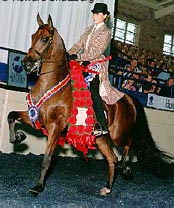National Show Horse
N/A
Wed, 13th November, 2024 - 3:22 pm GMT
Sponsor Ads:

Alternative Name
N/ABasic Info
The following traits are desirable: a. Motion - Balanced and obvious power from the hindquarters flowing into an elevated front end, the front legs showing both flexion and extension; b. Neck - Very long, set high on the shoulder and relatively upright with fine throatlatch. The neck should be shapely but without a pronounced crest; c. Head - Relatively small, and refined with large eyes and small, well-placed ears and a straight or slightly concave profile (a "roman nosed" or convex profile is not desirable); d. Pronounced withers and a very deep and well laid-back shoulder; e. Proportionately short back closely coupled with a long hip and relatively level top line (moderately sloping croup will not be penalized); f. Legs - Correct from all angles with long forearms and short cannon bones in front and long, well-angled pasterns front and rear; g. Refinement of bone but not lacking in substance, especially in the chest, girth, shoulder and hip; h. A relatively high-set tail, natural and flowing; i. When observed at rest or in motion, the horse must exhibit a natural presence and, when animated, extreme brilliance. The horse must exhibit high carriage when showing or relaxed.
Health
The ideal National Show Horse has a blend of the Arabian's beauty, refinement, strength and stamina with the Saddlebred's extremely long neck, high-stepping action and show ring charisma.Habitat
N/ABehavior
After its official beginning in 1982, the National Show Horse Registry allowed a period of open registration in order to collect a pool of horses that would be the foundation of the new breed. Today, the registry has established specific rules regarding the types of horses that may be used to produce National Show Horses. Three types of stallions and three types of mares can produce acceptable National Show Horse offspring -- Arabian, Saddlebred and National Show Horse. Both mares and stallions must be registered with their appropriate breed registries. Arabian and Saddlebred stallions, however, must also be nominated and approved by the NSHR board of directors. Any combination of the above three breeds of horse may be utilized for National Show Horse production as long as the resultant foal meets the blood content requirements ranging from 25 percent Arabian blood to 99 percent Arabian blood. The National Show Horse is exhibited in the following divisions: Halter, English Pleasure, Pleasure Driving, Country Pleasure, Fine Harness, Three Gaited, Five Gaited, Western Pleasure, Hunter Pleasure, Show Hack and Equitation.Origin
NorthAmericaHistory
The Arabian horse has been called "a living work of art" and the American Saddlebred has been termed "the peacock of the show ring." The combination of these two dynamic breeds, each with its own inimitable qualities, has produced a horse called the National Show Horse, an animal that truly combines the grace and beauty of the Arabian with the show ring charisma of the Saddlebred. The National Show Horse, as a show ring winner, had existed without a specific name or promotion for many years. There was a select group of horsemen and women in the early 1980s who believed that because of its consistent show ring success, combined with its athletic ability, beauty, endurance, attitude and heart, this Arabian-Saddlebred combination deserved a name and an organization to promote it. As a result, The National Show Horse burst on the scene in 1982 with more than just a name, it brought with it the first prize money system that would make it financially rewarding for exhibitors to show their horses. In its first National Championship Finals competition in 1984, the National Show Horse Registry paid out more than $100,000 in prize money.Common Foods
grassSponsor Ads:
Bok's Law: If you think education is expensive -- try ignorance.
National Show Horse
Coded by: BGID® | ALL RIGHTS RESERVED Copyright © 2000-2024
Disclaimer | Privacy | Report Errors / Contact | Credits

 Politician, US Vice President and President of the USA - Joseph Robinette Biden Jr.
Politician, US Vice President and President of the USA - Joseph Robinette Biden Jr.  President of the United States of America - Real Estate mogul, Pageant owner and now one of the most controversial men in political history.
President of the United States of America - Real Estate mogul, Pageant owner and now one of the most controversial men in political history.  versus
versus  Russia: 'The Evil Empire'? Are they all that bad or is it just the USA trying to portray Russia as bad because they are a world power with land bigger and a society very different from the USA ideal?
Russia: 'The Evil Empire'? Are they all that bad or is it just the USA trying to portray Russia as bad because they are a world power with land bigger and a society very different from the USA ideal?  Global warming has been in and out as the "latest" hot topic for many years. It is, according to modern scientists, the result of man-made industrial pollutants, clearing forested areas, agriculture, etc. But now they are thinking it started way before the Industrial Revolution...
Global warming has been in and out as the "latest" hot topic for many years. It is, according to modern scientists, the result of man-made industrial pollutants, clearing forested areas, agriculture, etc. But now they are thinking it started way before the Industrial Revolution... 
 Corona virus
Corona virus 
 Users with wide screen monitors can benefit from more content on every page.
Users with wide screen monitors can benefit from more content on every page.